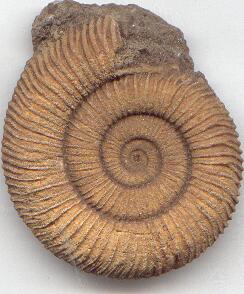 |
by Richard L. Howey, Wyoming,
USA
Image left: An ammonite. |
 |
by Richard L. Howey, Wyoming,
USA
Image left: An ammonite. |
No, I’m not going to write about certain kinds of trucks nor special types of railroad cars. I have something a bit more high-tech in mind—a flatbed scanner. In the last few years, this wonderful bit of computer technology has improved enormously and is now available at a quite reasonable cost.Some months ago, I obtained about 30 specimens of tropical butterflies. They came dried in small folded paper corners, with instructions on rehydrating and spreading them for mounting. However, I acquired them to study different types of scales and also the patterns of pigmentation colors and refractive colors, which meant that I would be scraping the wings and cutting sections of them—in other words, creating mayhem and generally ruining them. They are all quite lovely and I knew that I was going to feel a bit of a vandal. I remembered that Dave Walker had done some provocative and innovative articles on using a scanner and I thought—why not make a computer record of these butterflies before I mangle them. (See footnote). True, since they were dried and folded, I could only get the undersurface, but I decided at the time, that if the upper wing surfaces proved specially interesting—and I suspect they all will—I would cut so that the wings would be intact and then scan the uppers surfaces as well. To print the images, I used a good quality of imaging and photo paper with a brightness of 92, a weight of 37 pounds, and a matte finish. It costs $10 per 100 sheets and the images are quite satisfactory. If you want a glossier near-photography image, you can buy the special papers that cost about $10 for 10 sheets. For most purposes, and certainly for mine, the cheaper paper is fine.
Once I had scanned the butterflies, I started thinking about scanning a variety of other types of specimens. The first thing I did was go to an office supply company and purchase a box of the least expensive 8 ½" x 11" clear plastic sheets used for making transparencies for overhead projectors. Take one and place it over the glass bed of your scanner to protect it from getting scratched. Now you can try all kinds of bizarre things, but check the plastic sheet frequently for any tears or punctures and if you find any, remove the old sheet and replace it.
Size, and particularly the thickness of specimens, are major considerations in obtaining good scans. I tried some mineral specimens, starfish, sea fans (soft corals), sand dollars, sea urchins, flowers, and the glass sponge, Euplectella. Once you get started all kinds of possibilities occur to you and I also discovered that certain plant leaves and feathers are especially good subjects for scanning. I dug out an old book of construction paper of various colors and experimented with using different sheets for different specimens to enhance contrast. This is a matter of trial and error, since the results will vary with the type of specimen and its colors and with the aesthetic sensibilities of the individual. For many specimens, such as Euplectella, I found that a light blue background worked quite nicely. For the peacock feather, I used a plain white sheet of inkjet paper which produced an effect that I found very pleasing. The image has, at least when I printed it out, more the character of a hand-colored print than a computer scan.
I bought some inexpensive, but attractive 3-ring binders and some boxes of plastic sheets with 3 holes especially for mounting and projecting 8½" x 11" sheets. Here it is worth spending a bit extra to get good quality plastic sheets that will protect your archiving, since you have already invested a lot of time, energy, and some money in getting good prints. You can, of course, mount two pages in each plastic sheet, so a box of 50 sheets will protect 100 prints.
Once this idea of creating a flatbed catalog took hold of me, it was initially like a demonic possession; I wanted to scan and catalog 35 years of accumulation which, of course, is preposterous. When I regained partial sanity, I realized that I would have to proceed slowly, methodically, and selectively, but, unfortunately, I keep acquiring new specimens that need to be scanned. However, this can be a distinct advantage, for as one of my friends and colleagues said recently: “I have so many projects to finish that I will have to become immortal.”
All comments to the author Richard Howey are welcomed.
Scanned Images
Editor's Footnote: Some Micscape articles with flatbed scanner images.
Topical tips 3 - using a flatbed scanner for slides (Dave Walker)
Digital macroscopy in Autumn with an A4 flatbed scanner (Dave Walker)
Digital macroscopy in spring with a flatbed scanner (Dave Walker)
Investigation of the red mangrove-tree crab using the computer scanner and the Intelplay QX3 microscope (Hugh Mitchell-Tapping)
Hooked on cleavers (Paul James)
Victorian papered slides (Bill Ells)
Please report any Web problems or
offer general comments to the
Micscape
Editor,
via the contact on current Micscape
Index.
Micscape is the on-line monthly magazine
of the Microscopy UK website
at Microscopy-UK